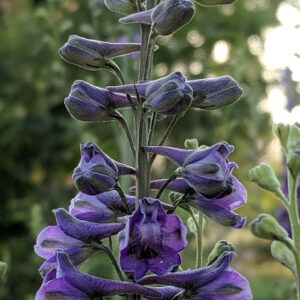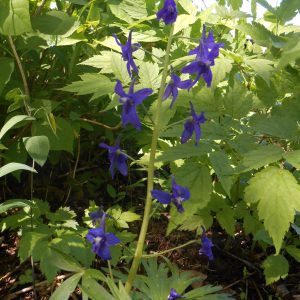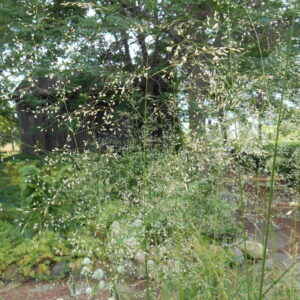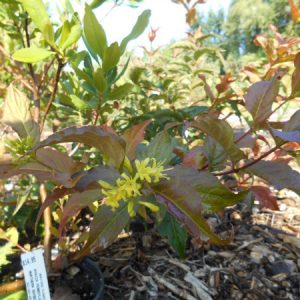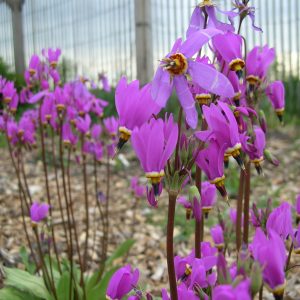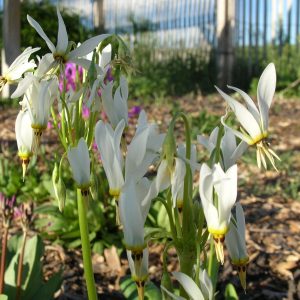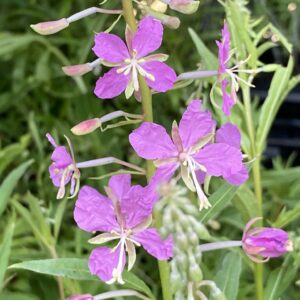Wisconsin Native
- Sorry, this product cannot be purchased.
Showing 41–48 of 108 results
-
Delphinium exaltatum Tall Larkspur, American larkspur Z 4-8
Fabulous, not because of a big flower-head, but because it grows everywhere with no special care, graceful lavender or purple spikes of trumpets on tall stems in July to August and beyond.
Fabulous, not because of a big flower-head, but because it grows everywhere with no special care, graceful lavender or purple spikes of trumpets on tall stems in July to August and beyond.
Size: 3-4' x 9"
Care: sun to part shade in moist well-drained soil. Withstands winds, no staking needed. Not fussy. Let the seeds drop & you’ll get babies.
Native: Pennsylvania to No. Carolina west to Ohio & Alabama
Wildlife Value: attract hummingbirdsDelphinium, named by Dioscorides, is Greek for “dolphin” due to the resemblance of the flower shape. According to William Aiton (1731-1793), early director at Kew Royal Garden, Quaker nurseryman and explorer John Bartram (1699-1777) sent it to England. London’s Chelsea Physic gardener Philip Miller grew it in 1758. Jefferson planted this at Monticello in the NW quarter of the outer border in March 1811.
-
Delphinium tricorne Dwarf larkspur, Spring larkspur Z 4-8
Spring ephemeral of blue delphinium elf-cap spikes. Substitute these for tulips, a favorite food of deer and rabbits
OUT OF STOCK – Available to order in Spring only
Spring ephemeral of blue delphinium elf-cap spikes. Substitute these for tulips, a favorite food of deer and rabbits
Size: 18-24” – 6-9”
Care: sun to shade in moist well-drained to moist soil
Native: Pennsylvania to Iowa, south to Alabama and Oklahoma and states in between
Wildlife Value: food for hummingbirds and butterflies; deer & rabbit resistant.Collected by André Michaux c. 1800. Cherokee used this for heart ailments and reported that it makes cows intoxicated and they die. The name tricorne comes from the 3-cornered shape of its seeds, like the shape of colonial hats with brims turned up on three sides. This is breathtakingly beautiful but slow to grow. It is also an ephemeral and dies back after going to seed so mark it or have a good memory where it is so you don’t dig into it planting something else. It comes back in spring.
-
Deschampsia caespitosa Hair grass Z 4-9
Airy pink panicles, like delicate billowing clouds of seed heads, top clumps of arching slender leaves in mid- summer persisting through winter.
Airy pink panicles like delicate billowing clouds of seed heads, top clumps of arching slender leaves in mid-summer persisting through winter.
Size: 2-4' x 18"
Care: moist soil in sun to shade
Native: Europe, Asia & No. America, Wisconsin nativeDeschampsia named for French botanist Deslongchamps (1774-1849.) Caespitosa means that it grows in clumps. Named and described in 1753.
-
Diervilla lonicera Northern bush honeysuckle Z 3-7
Lemon yellow flowers on this short shrub June to August. In fall its foliage turns dark red for the final fireworks’ display. Great shrub for tough, dry shady areas.
Lemon yellow flowers on this short shrub June to August. In fall its foliage turns dark red for the final fireworks’ display.
Size: 3’ x 3’ spreading
Care: sun to part shade in well-drained soil, drought tolerant
Native: Eastern half of US & Canada, Wisconsin native.
Wildlife Value: nectar source for Bumblebees. Birds make nests from the branches and eat the fruitsUsed medicinally by numerous Native Americans – Algonquin, Chippewa, Cree, Iroquois, Menominee, Meskwaki, Ojibwa and Potawatomi. Used as remedy for sore eyes, diuretic, “old men who cannot retain urine,” constipation, stomach pain, increase breast milk, to “spoiled babies with adulterous mother,” STD’s and vertigo. Dr. N. Dierville, a surgeon, carried this to France from Canada (then Acadia) in 1699. Botanist to France’s king, Louis XIV, Joseph Pitton de Tournefort (1656-1708) named this to honor Dierville
**LISTED AS OUT OF STOCK BECAUSE WE DO NOT SHIP THIS ITEM. IT IS AVAILABLE FOR PURCHASE AT OUR RETAIL LOCATION.
-
Dodecatheon meadia syn. Primula meadia Pink Shooting Star Z 4-8 Ephemeral
Rosy-lilac reflexed flowers, looking like a descending shuttlecock, dangle from stems in spring
OUT OF STOCK – EMAIL FOR AVAILABILITY
Only available for purchase in spring – Ephemeral
Rosy-lilac reflexed flowers, looking like a descending shuttlecock, dangle from stems in spring
Size: 12-24” x 6-12”
Care: sun to part shade in moist well-drained soil.
Native: PA to Wisconsin, south to TX.
Awards: Royal Horticultural Society Award of MeritName Dodecatheon from the Greek dodeka (twelve) and theos (gods), meaning 12 superior gods, after the name given to another plant by Roman author, Pliny the Elder. The species name meadia after Richard Mead, physician to George III. John Tradescant the Younger sent this to England by 1640. “A favorite among old border flowers.” William Robinson, 1899.
-
Dodecatheon meadia syn. Primula meadia Shooting Star Z 4-8 Ephemeral
White reflexed flowers, looking like a descending shuttlecock, dangle from stems in spring. Ephemeral.
Available to order in Spring only
White reflexed flowers, looking like a descending schuttlecock, dangle from stems in spring. Ephemeral.
Size: 12” x 6”
Care: part shade in moist well-drained soil.
Native: PA to Wisconsin, south to TX.
Awards: England’s Royal Horticultural Society Award of Merit.Dodecatheon from the Greek dodeka (twelve) and theos (gods), meaning 12 superior gods, after the name given to another plant by Roman author, Pliny the Elder. The species name meadia after Richard Mead, physician to English King George III. John Tradescant the Younger sent this to England by 1640. “A favorite among old border flowers.” William Robinson, 1899.
-
Echinacea pallida Pale purple coneflower Z 4-8
Narrow, weeping pink rays in early to mid-summer surround its coppery-orange, hedgehog-like cone.
Narrow, weeping pink rays in early to mid-summer surround its coppery-orange, hedgehog-like cone.
Size: 2' x 14"
Care: Full sun in well-drained soil. Drought tolerant.
Native: much of continental US east of Colorado
Wildlife Value: deer resistant. Nectar feeds butterflies and hummingbirds. Birds eat seeds
Awards: Great Plants for Great PlainsEchinacea is Greek meaning hedgehog referring to the bristly conehead. Used to cure many ailments – arthritis, rheumatism, burns, colds, boils, fever, sore mouths, throats & gums, toothaches, snakebites, headaches, stings and distemper in horses – by several tribes – Cheyenne, Crow, Dakota and Sioux. 1st collected by English planthunter Thomas Nuttall (1786-1859) in Arkansas. Nuttall searched entire No. American continent, parts of Canada, from New England west to Oregon, the South, Midwest, the Plains, the S.E., California & Hawaii finding thousands of new plants.
-
Epilobium angustifolium syn. Chamaenerion angustifolium Fireweed Z 2-7
Bright pink to lilac purple flowers June-July atop red stems covered in willow-like leaves
OUT OF STOCK
Bright pink to lilac purple flowers June-July atop red stems covered in willow-like leaves
Size: 2-6’ x 3’ spreading
Care: Sun to part shade in dry to moist well drained soil
Native: Circum-polar to the temperate northern hemisphere. Wisconsin native.
Wildlife Value: Attracts hummingbirds, bees, and butterflies. Host for Fireweed Clearwing moth and Nessus Sphinx moth. Fireweed pollen yields a honey so prized that some Canadian beekeepers drive - or even fly - their hives to areas rich in fireweed for the blossoming season.Common name comes from its quick reappearance after a wildfire. Native Americans used fireweed externally for burns and other skin conditions and made a tea for gastro-intestinal and bronchial problems. Its shoots eaten as a vegetable and young leaves added to salads. Described and named in 1753.
**LISTED AS OUT OF STOCK BECAUSE WE DO NOT SHIP THIS ITEM. IT IS AVAILABLE FOR PURCHASE AT OUR RETAIL LOCATION.

